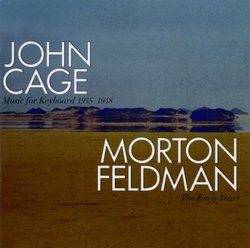| All Artists: John Cage Title: John Cage: Music for Keyboard 1935-1948/Morton Feldman: The Early Years Members Wishing: 3 Total Copies: 0 Label: New World Records Original Release Date: 1/1/2007 Re-Release Date: 6/1/2007 Genres: Dance & Electronic, Classical Styles: Chamber Music, Forms & Genres, Short Forms, Historical Periods, Classical (c.1770-1830), Modern, 20th, & 21st Century, Instruments, Strings Number of Discs: 2 SwapaCD Credits: 2 UPC: 093228066422 |
Search - John Cage :: John Cage: Music for Keyboard 1935-1948/Morton Feldman: The Early Years
 | John Cage John Cage: Music for Keyboard 1935-1948/Morton Feldman: The Early Years Genres: Dance & Electronic, Classical
|
Larger Image |
CD Details |
CD ReviewsHow it began Personne | Rocky Mountain West | 09/20/2009 (4 out of 5 stars) "There are many composers who are best known for their influences on composers who came after. This list would include Salieri, Zemlinsky, Busoni, and perhaps both Cage and Feldman. For a great many Cage was the greater evil, vanquishing both causality and order from his music. This view is held firmly by many listeners who haven't heard a note of it. This double CD provides a fine opportunity to hear two young composers, beginning as their own influences are clear and as they branch away into new territory.
The earliest Cage piece on this set is a two-movement piano set from 1935, as Cage studied with Arnold Schoenberg. It clearly shows the influence of the older composer, if somewhat awkwardly. The second movement is quite kinetic and appealing. This piece is roughly bookended by another two movement piece from over a decade later. That second piece is much darker and much more compositionally assured, but by this point it was out of the mainstream of Cage's work. With a single exception, the rest of the Cage in this set is for 'prepared' piano. The piano is modified by attached screws, blocks of wood, nuts and bolts and so on. This was not a haphazard process at all, but was the result of careful listening by Cage. The result is remarkable. Some notes sound like log drums. Some sound like gongs or other metallophones. Other effects are harplike and some bring out strong harmonics. There are even piano sounds in there! The preparation is different in each case. I hear these pieces as percussion ensembles, with each voice carefully considered. The recording is very close, giving the pianist's perspective. I think this is appropriate--the music is extremely personal and introspective, and the effects are not likely to hold up at any distance from the piano. These pieces are generally short and do not wear out their welcomes. Best-known among them (and rightly so) is 'The Perilous Night'. The last of the Cage pieces is a set of five very short pieces for toy piano. Considering the limited gamut of the instrument, Cage does well to create a serious piece with it. At the same time, this one is probably more fun to see than to hear. The CD makes it clear that John Cage did not come from Mars. Like any other young composer, he had his influences and struggled to find a direction of his own. At this stage of his life, he is considerably less radical than a number of his peers (Morton Feldman among them). His harmonic palette is quite limited and his ability to develop material is often a little clumsy. At the same time, he felt increasingly free to head down pathways that were little-traveled. One may legitimately say that he himself did not reach the promised land, but he must get credit for the many trails he blazed. The remaining third of this set is dedicated to Morton Feldman. In some circles, he is considered as a father of minimalism. This is most unfair, since his music actually has considerable substance, even at this early point. The most obvious influence is Webern--there is often more silence in Feldman's music than there is sound. But while Webern's music always sounded Viennese, Feldman is something else. Not every piece in this set is a masterpiece, but one is always struck by the boldness of concept. My two favorites (that list is likely to grow) are 'Structures for String Quartet' (also available in a nice performance by the Concord Quartet) and 'Piece for Four Pianos'. 'Structures' is a tiny gem of clockwork. It has about as much forward motion as you'll ever hear in Feldman, but is still fine-faceted and transparent. In 'Four Pieces for Piano', all four pianists play the same music, but with each player choosing his or her own pace. At the beginning of the piece, you may find yourself listening as if it is counterpoint. Events are close enough to one another to hear canonical effects. This becomes more difficult as the piece continues and players become more separated. At this point you must listen on different terms. There are some points of near-synchrony that make it clear how carefully players are paying attention. This attention is required by the listener as well. Feldman is a master of detail--it is up to the listener to fill in the larger form, but it is there. This is a reissue of an LP set that is now a half-century old. The Cage pieces are all ably performed by Jeanne Kirstein. The Feldman pieces use more performers, but the groups are centered around David Tudor and Matthew Raimondi. While there's a tiny bit of tape hiss, the recording and performances are first-rate. Belated thanks is owed to Columbia Records who issued the original set. These were the days that major record labels felt some obligation to sustain high culture even when most of their income came from music of considerably less ambition. Many thanks to New World records for keeping this recording alive." |

 Track Listings (10) - Disc #1
Track Listings (10) - Disc #1